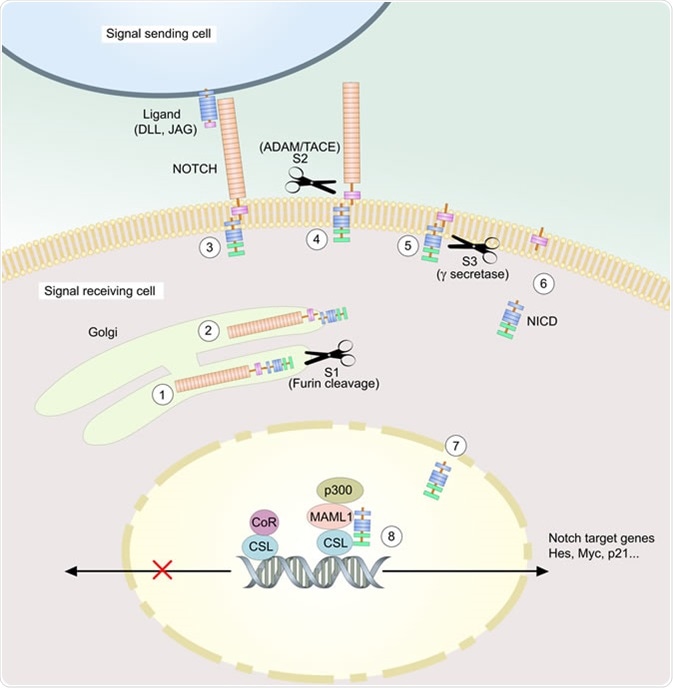The notch signaling pathway plays a major role in regulating various cellular processes during development, therefore dysregulation of this pathway can lead to disease.

Notch signaling pathway. Image Credit: Ellepigrafica / Shutterstock
This basic signaling pathway has been used repeatedly in development, after initially being discovered in Drosophila. It has since been discovered that the notch signaling pathway is involved in multiple developmental processes, including hematopoiesis, somitogenesis, vasculogenesis, and neurogenesis. Overall, it functions to influence downstream processes, including self-renewal process of stem-cell conservation, proliferation, specification of cell fate or differentiation, and apoptosis.
The Notch pathway is considered as a linear mechanism, where a ligand induces a receptor which subsequently results in transcriptional changes in the nucleus. Mutations or altered signaling output in the pathway results in dysregulated Notch signaling, which is associated with many types of disease.
The Notch signaling pathway
Alagille Syndrome
Alagille syndrome (ALGS) is an autosomal dominant disorder. In this disorder, developmental abnormalities are observed in the liver, heart, eye, skeleton, and other organs. Neonatal jaundice and cholestasis are common in ALGS patients due to the lack of intrahepatic bile ducts.
Common features of ALGS are cardiac defects, skeletal defects, ophthalmological abnormalities, renal and pancreatic problems, and intracranial bleeding. Mutation in the JAG1 gene, which is a Notch signaling ligand, is the primary reason behind ALGS.
Prominent forehead, deep-set widely spaced eyes, a straight nose and pointed chin are the common facial characteristics of ALGS patients. Studies reported that Notch signaling is crucial for mid-face development.
CADASIL
CADASIL (Cerebral Autosomal Dominant Arteriopathy with Subcortical Infarcts and Leukoencephalopathy) is a type of neurologic disorder. The common clinical manifestations of the affected individuals are migraine with aura, mood disorders, recurrent subcortical ischemic strokes, declined cognitive progress and dementia. The affected patients also exhibit premature death. Mutations in the NOTCH3 gene results in CADASIL.
Spondylocostal Dysostosis (SCD) and Spondylothoracic Dysostosis (STD)
Segmentation is essential for the development of vertebrate animals, and occurs through somitogenesis. The notch signaling pathway is a crucial regulator of this process. Spondylocostal Dysostosis (SCD) and Spondylothoracic Dysostosis (STD) are caused by mutations in genes encoding components of the notch signaling pathway. They are characterized by severe abnormalities in vertebrae and intercostal muscles. SCD and STD are categorized into abnormal vertebral segmentation (AVS) disorders.
Hajdu Cheney Syndrome
Mutations in the NOTCH 2 gene lead to the development of a rare condition called Hajdu-Cheney. The primary manifestations of this condition are focal bone destruction and osteoporosis. Other features of this condition include craniofacial abnormalities, renal cysts, cleft palate and cardiac defects.
Brain Tumors
Dysregulation of the Notch signaling pathway is associated with the development of human malignancies such as T-cell leukaemia, breast and colon related carcinomas, and cervical cancer. Recently, it was observed that Notch pathway plays a role in brain tumorigenesis. Expression of abnormal Notch ligand was observed from human tumors of glial origin in a recent study.
Retinal Dysplasia and Retina Vascular Homeostasis
In vertebrate, the retina plays a significant role in the vision pathway. Congenital blindness or vision disability occurs in individuals due to retinal dysplasia. Furthermore, neovascularization related diseases occur in adults because of adult retinal vascular homeostasis. Studies have also indicated that disruptions to the Notch signaling pathway could play a role in neural retina dysplasia and vascular abnormality.
Further Reading